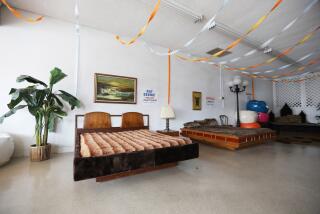NUTS & BOLTS : A how-to for homeowners : Water Bed Has Fulfilled the Promise Made in ‘60s
- Share via
Remember the first time you heard about water beds, back in the ‘60s? The people who sold them were screaming, with a straight face, about what a great night’s sleep you’d get if you bought one. The liquid mattress would conform lovingly to every contour of your body and you’d undulate your way into dreamland on gently rolling swells. It was, they said unapologetically, the wave of the future.
Of course that was pretty hilarious back then. Everybody knew what a water bed was really for, or thought they did. It had a heck of a rep. It was supposed to be the sexual equivalent of center court at Wimbledon, the most effective piece of seduction equipment since the Mercedes-Benz 450 SL. You weren’t, for God’s sake, supposed to sleep on it. (A few people couldn’t. For them, lying on a rolling water bed after a big plate of clam linguine and high-octane Chianti was like watching “Moby Dick” with the stomach flu.)
But that was then. Today, some of us are a bit less brazen (read: older) and there’s at least an even chance that when we hit the sack at night we’re eventually going to go to sleep. And guess what? The water bed people are still out there, and they’re using the same old sales pitch.
The difference now, however, is that people appear to be listening to it.
The reason the water bed didn’t supernova along with patchouli incense and the Maharishi is that “it fulfilled its promise, and that promise was a better night’s sleep,” says Bill Martinez, director of marketing for Waterbed Gallery.
Today, Martinez says, the water bed industry in the United States accounts for about $2 billion in retail sales each year, and water beds find their way into one household in five.
A lot of jitters had to be overcome to get that kind of market penetration. Among them:
They’ll leak. Some of the original ones did, with some fairly messy and embarrassing results.
“That used to be the four-letter word of the water bed industry,” says Martinez. “It was like chalk on a blackboard.”
The new models, however, are the subjects of much tighter quality control and improved design, says Martinez. It’s probably still not such a hot idea to jump up and down on a water bed in a pair of stiletto heels, but these days you almost need a bayonet to force one to leak.
They’ll crash through the floor. Yes, they’re heavy, but they’re not that heavy. Landlords, in particular, used to believe that if they rented to a water bed owner, the bed would end up cracking the support beams and come hurtling down into the apartment below. The California Legislature disagreed, however, and in January, 1988, a state law prohibiting landlords from barring water beds went into effect.
Water bed retailers will tell you that your refrigerator likely exerts more pressure on the floor area it sits on than does a water bed, because the bed’s weight is distributed over a large floor area.
They’ll make me urp. OK, so the old ones were a little on the nautical side. Today, however, about 50% of the beds sold, according to Martinez, are of the “waveless” variety. The vinyl mattress contains a series of baffles that dampens the motion of the water.
“People think back to the late ‘60s when they first got involved with water beds,” Martinez says, “and they remember it was kind of free flowing and they bounced from one side of the bed to the other. Now, they’ve moderated the movement to such a degree that it’s totally waveless. We’ve done demonstrations where we’ve put a wineglass full of wine on the top of a bed and had someone jump on it and not spill the wine.”
Yet another improvement over the old days will particularly please the design-minded: variety. In their infancy, water beds were mostly pine boxes filled with water. They were massive and masculine, because the first buyers were 85% men.
“I called them Viking-design beds,” says Martinez. “They looked like you bought them by the pound.”
Now that there are almost as many female water bed buyers as male, the industry has “become more fashion-oriented,” Martinez says, and offers many different styles and materials.
One type, known as the soft-sided water bed, may be the most versatile of all. The water-filled reservoir is surrounded not by hard material, such as wood, but by soft material similar to that in a conventional mattress. The result is a bed that is visually almost indistinguishable from a conventional mattress and box spring set. It also can accommodate conventional fitted and flat sheets.
The soft-sided beds tend to appeal to the over-35 buyers who may already have bedroom furniture of a certain style and don’t want to change it to accommodate a hard-sided water bed, says Martinez.
Before you decide to plunk down your cash, however (a water bed can cost anywhere from about $125 for the bare essentials to more than $3,000, complete with matching bedroom furniture), spend a little time on one. Stretch out on a few in the store’s showroom or, better still, take a snooze on one if you know someone who has one and won’t mind. For some people, they take a bit of getting used to.
Now, the big question: Will you sleep better on a water bed? Retailers will say yes, because the water eliminates the pressure points on the body, exerted by a conventional mattress, that cause discomfort. Dr. Mike Dickel, the administrative director of the UC Irvine Sleep Center says, however, that psychology may be just as responsible for comfort as physiology. If people think they’re more comfortable on a water bed, he says, they’ll probably sleep better.
Now, the really big question: Will a water bed set your romantic life ablaze? Yes, if it’s accompanied by flowers, expensive French food, soft saxophone music, close dancing, the whisper of rustling silk, the scent of night-blooming jasmine wafting over the balcony rail on the summer air, and lots of Perrier-Jouet, it’s virtually assured.
More to Read
Inside the business of entertainment
The Wide Shot brings you news, analysis and insights on everything from streaming wars to production — and what it all means for the future.
You may occasionally receive promotional content from the Los Angeles Times.









